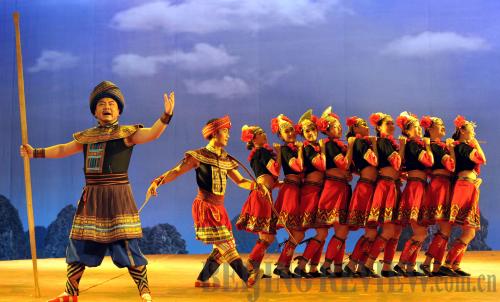|
 |
|
Dancers of the Zhuang ethnic group perform their unique opera in the city of Liuzhou, southwest China's Guangxi Zhuang Autonomous Region, on October 5, 2011 (ZHANG AILIN) |
The 4th National Ethnic Minorities Art Festival will be held in Beijing between June 7 and July 6, announced Danzhu Angben, Deputy Director of the State Ethnic Affairs Commission of China, at a press conference in Beijing on May 17.
According to Danzhu, the festival aims to show the wonderful cultural and artistic achievements collectively made by young generations from various ethnic minority art troupes around China.
"The art festival is attended by 41 troupes across the country, including Hong Kong and Taiwan, and each troupe will present audiences one play or opera representative of the uniqueness of a local feature or minority," Danzhu said.
There will be 92 performances in nine theaters in Beijing during the month-long art festival. To meet common people's needs for stage art, tickets are priced between 30 yuan ($4.70) and 300 yuan ($47.50), much lower than commercial performances.
Remarkable progress
China is a unified multi-ethnic country, which consists of 56 ethnic groups. The Central Government and its administrative bodies at all levels have always been devoted to the preservation and development of ethnic minorities' cultures and arts. According to Danzhu, China has obtained remarkable achievements for its ethnic minority cultural causes in recent years.
For example, since the implementation of the project for intangible cultural heritage protection in 2003, China has listed 1,219 items of national intangible cultural heritage in three batches. Among them, 515 items come from ethnic minority groups, accounting for 42 percent of the total.
In the Tibet Autonomous Region, a total of 106.62 million yuan ($16.87 million) has been invested since the launch of the Rural Library Project in 2007 for the construction of 5,331 rural libraries, which cover more than 92 percent of villages. Moreover, 80 percent of the books are written in the Tibetan language. These libraries have proven to be an effective solution to difficulties for the farmers and herdsmen to acquire knowledge and learn of new technologies.
As of 2010, there were 10,282 ethnic cultural institutes across the country, including 651 performing arts groups, 604 libraries, 643 cultural centers and 240 museums. The number of cultural institutes per 100 thousand people in ethnic minority-inhabited areas is above the national average, according to Danzhu.
"But the cultural causes of some ethnic minorities are still imbalanced and slow, largely due to the undeveloped economic and social conditions of these ethnic areas," Danzhu said. There is a lack of adequate public infrastructure for culture and education services in some remote areas. Therefore, "China has announced in the 12th Five-Year Plan to boost the cultural development and prosperity of ethnic minorities in the near future," Danzhu said. | 